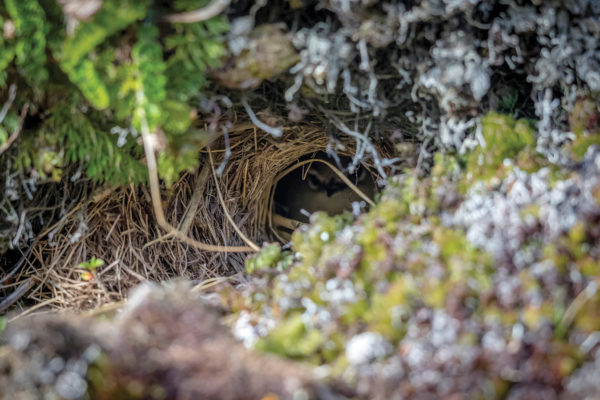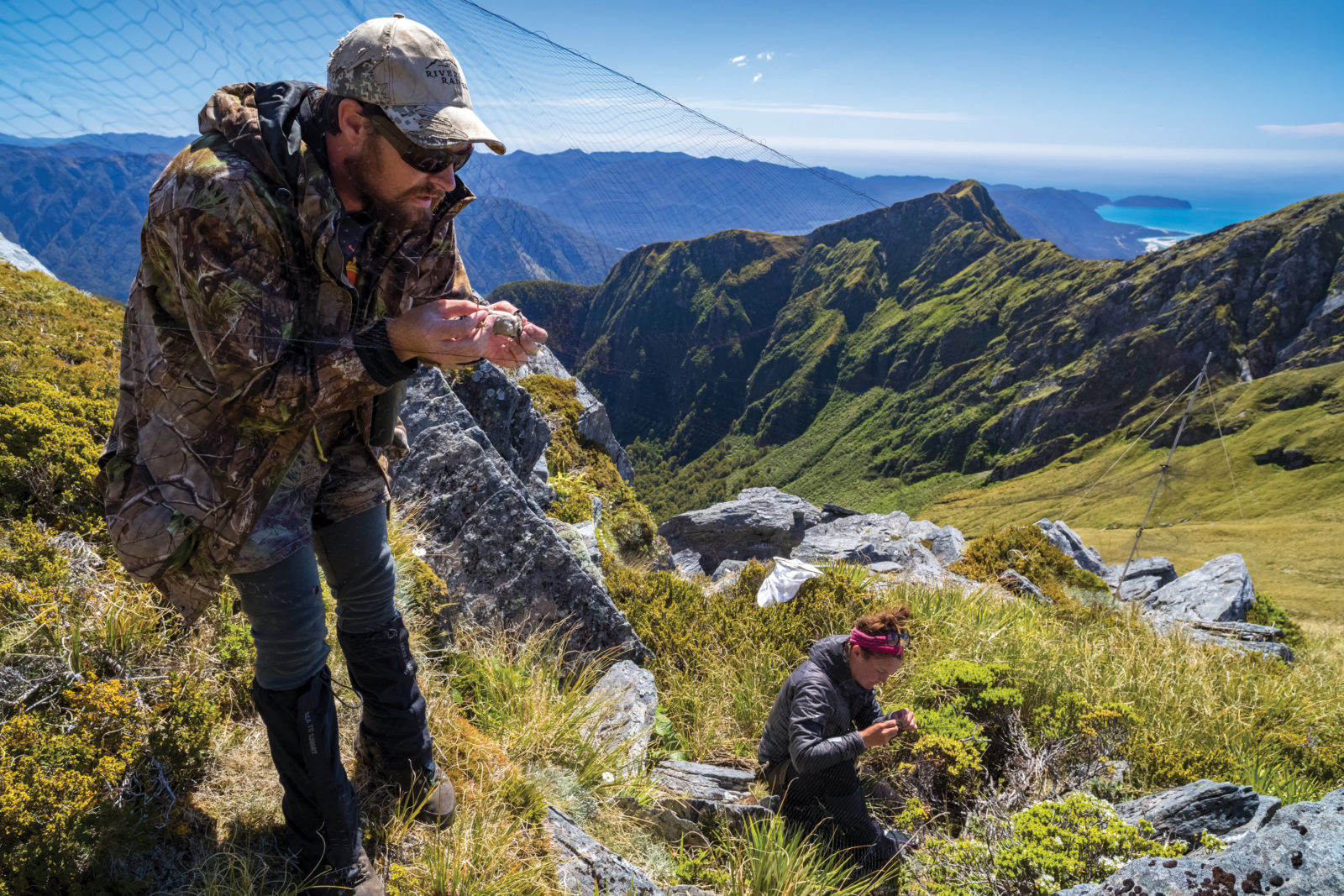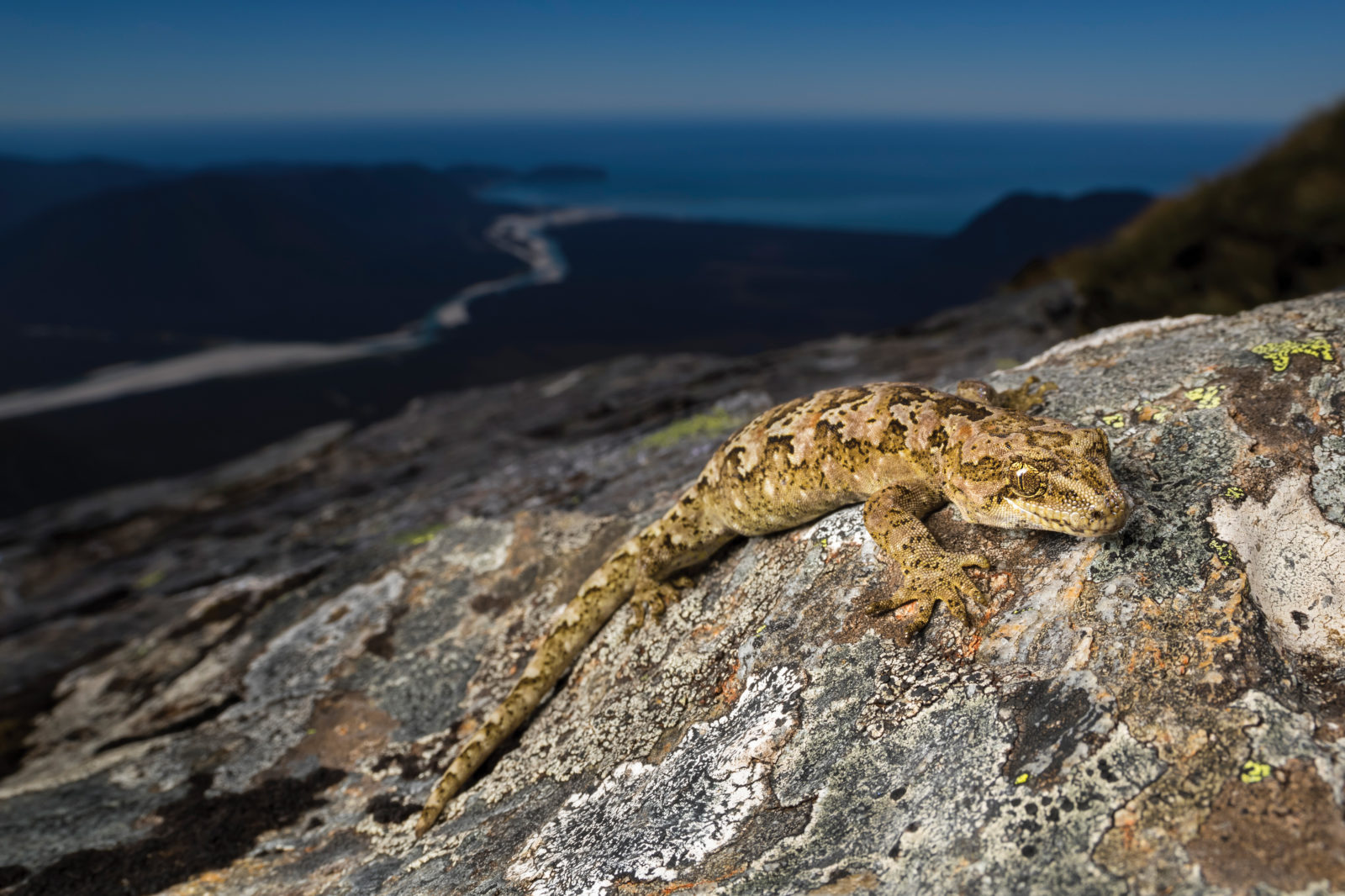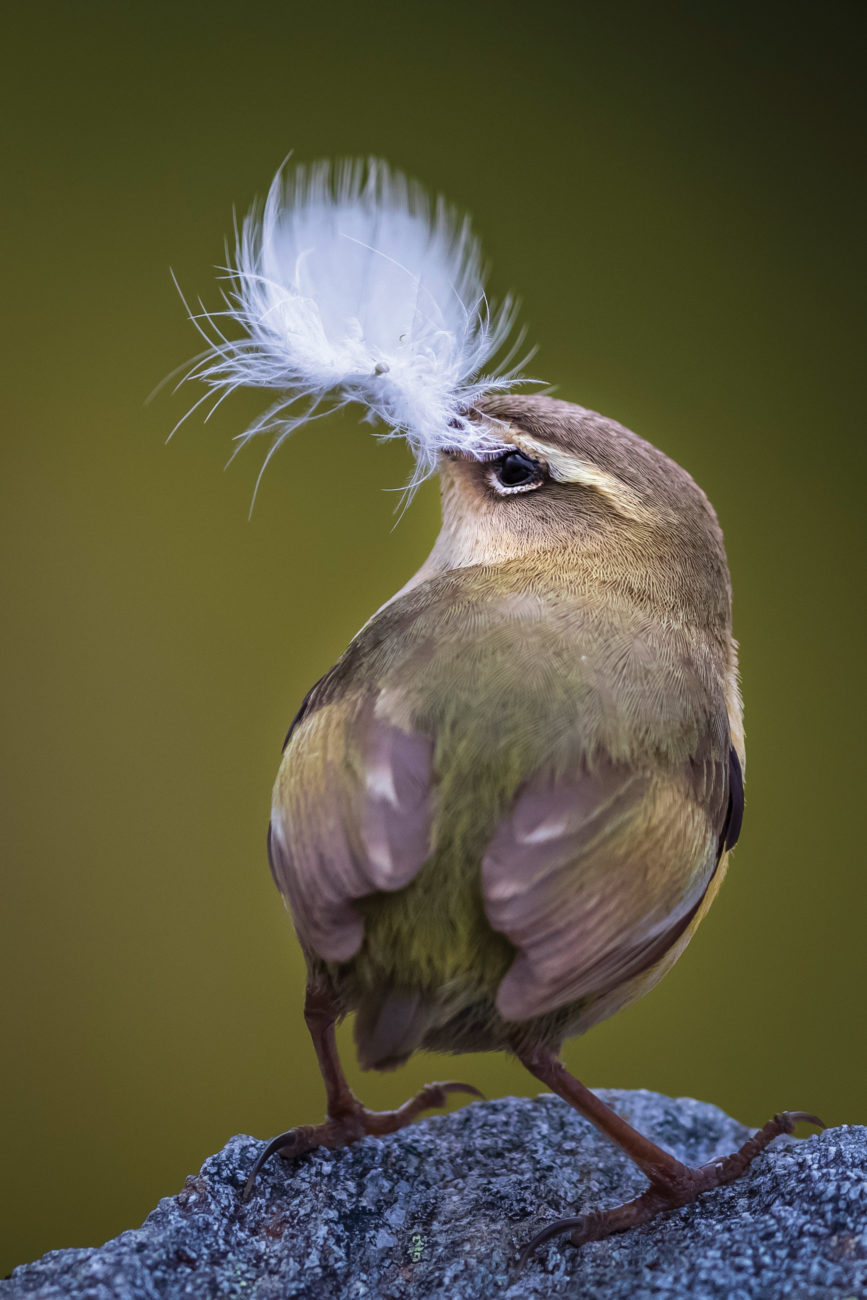
The great retreat
Some species just like it cooler. Others have withdrawn little by little to higher altitudes, making new homes where it’s too cold for their enemies to follow. But warmer seasons allow predators and diseases to gain ground and advance above the bushline—meaning that the alpine zone is no longer the refuge it once was.

At the bushline, the upper limit of altitude beyond which no trees grow, snow tussocks take over from forest. Golden, ancient, and almost as tall as a person, tussocks give the high country its bronzed colour.
They also behave strangely—flowering and producing seeds on an irregular basis, working to rhythms dictated by climate. Warm summers trigger flowers the following year, and every few years, what’s known as a ‘mast’ season occurs. In these years, tussocks flower en masse, a strategy that they evolved to ensure all their seeds weren’t eaten by predators.
In the 1960s, ecology student Alan Mark—now Sir Alan—began transplanting clumps of tussock up and down Central Otago hillsides, even planting some at sea level in Dunedin, to find out how they would respond to changes in altitude.
Mark’s experiments, still running today, provide a valuable set of records for scientists trying to figure out what effects a changing climate will have on the high country.
Snow tussocks, Mark has concluded, are highly resilient to temperature change.
“The ones in Dunedin were absolutely huge, and they flowered annually,” he tells me.
“They can cope with warmer temperatures. Whether they can cope with the competition remains to be seen.”
Plant species which prefer warmer temperatures may start moving into upland regions, forcing out higher-altitude specialists. In the most extreme case, goes one theory, the bushline could advance upwards, swallowing up habitat for sub-alpine species.

Little is known about how our native alpine plants will respond to warmer temperatures, and while Mark has few fears for the resilience of tussocks, there are less conspicuous plant species he is concerned about. A species of alpine forget-me-not called Myosotis oreophila, for example, is found only in a single, half-hectare patch of tundra, right below the brow of the Dunstan Mountains.
Mark is worried these and other plants will be forced to retreat uphill in a changing climate.
“If the temperature warms to the point that they can’t cope, they’d be lost,” says Mark. “They’ve got so little space to operate on.”
Warmer temperatures are already
affecting the alpine zone, and the plants and animals within it. How they’re affected is something that scientists are scrambling to figure out.
[Chapter Break]
“Everything’s lined up for the biggest rodent year we’ve ever had,” says Susan Walker, a biodiversity researcher at Manaaki Whenua–Landcare Research.
Every few years, beech trees, like snow tussocks, mast. In New Zealand’s forests, this provides a bonanza of fallen seeds for predators to feed on.
Last summer’s mast, which followed the hottest summer on record, was monumental.
“It wasn’t only the beech that flowered,” says Walker. “It was also lowland forest trees and tussocks above the treeline.”
Rats and mice fed up large through summer and autumn. Then winter, as we know it, failed to arrive.
“It’s just been so warm,” says Walker. “Rats and mice will have bred right through the winter. There’s just this carpet of rodents. When spring comes, they’re just going to go gangbusters.”
As well as reaching plague numbers, predators are also advancing into higher and higher country, into areas previously assumed to be safe.
In a recent study, Walker and her team analysed data from two Bird Atlases spanning 40 years, comparing the number of birds in warm lowland forests with populations in cool high-altitude forests.
[sidebar-1]
“We realised we were onto quite an important story,” she tells me, “which was really the decline of forest birds between the 1970s and the early 2000s.
“The forest birds were already rarest in the warmer forests, and were hanging on in colder forests, and that pattern just accentuated between the two atlases.”
Native birds have been pushed up-slope by predators, a phenomenon Walker calls “thermal squeeze”. Bigger, fruit-eating birds have been hardest-hit.
“Things like kererū and kākā, which need more resources to sustain a viable population, are really caught between a rock and a hard place, because the productive forests, where they would optimally hang in, are the most saturated by predators.”
High-altitude beech forests contain very little fruit compared to lowland conifer-broadleaf forests, making it more difficult for these birds to survive. Insect-eating birds, which are smaller and more mobile, have more success.
“What people think of as beech-forest birds, like orange-fronted kākāriki, mohua, and riflemen, are now pretty much confined to the coldest parts of our forest.
“There’s a saying in ecology, that you don’t find species in the places that are most suitable for them; you find them in places that are least suitable for their natural enemy. That seems to be a really clear pattern with New Zealand’s endemic birds.”
Now, even the haven of upland forests may be compromised, as climate change tips the scales in favour of the invaders. Mice and stoats are already present above the treeline, but with warming temperatures, rats and possums are moving up in the world, too.
Rats can breed every two to three months, so when conditions are right, their populations explode exponentially. The more rats there are to begin with, the worse the plague.
“In the past, high-altitude forests were really rat-free most of the time,” says Graeme Elliott, principal advisory scientist with the Department of Conservation, “so when a mast came along, [the rats] started from nothing and struggled to make a rat plague. But as it gets warmer, there’s not many places where there’s no rats at all, so every time there’s a mast, the rats start from slightly higher levels.
“The difference between one and two rats at the beginning is minuscule, but when you get up to the difference between 100 and 200, or one million and two million, it becomes significant.”
[Chapter Break]
“It used to be thought predators weren’t such an issue above the treeline,” says Kerry Weston, a Department of Conservation scientist. “But applying that logic to mustelids might have been a little bit misguided.”
While the movements of predators in our forests have been extensively studied, scientists are only starting to bring the same level of scrutiny to areas above the bush. Weston and her alpine research team have spent the past six years running studies at seven mountain sites around the South Island, picking apart the mechanics of predation in high-altitude areas.
Stoats are Ice Age champions which evolved to live and hunt in cold, dry conditions. They feed primarily on hares, rats and mice, but also take a heavy toll on native birds, lizards, and insects. Unlike rats, they bear just one litter a year, but they can alter the number of young they give birth to in accordance with how much food is available. When conditions are good, it’s a sure bet stoats will be raising large broods of youngsters. And as rats move further up-slope, this could provide the stoats with even more fuel—a brutal feedback loop.


Right in the firing line are rock wren, tiny endemic birds that make their home among the bluffs and crags of the Southern Alps. Rock wren are New Zealand’s only true alpine birds, spending their entire lives above the treeline. They are the mountaineering cousins of the forest-dwelling rifleman—the last two species remaining from a lineage of eight endemic New Zealand wrens.
Weston and her fellow researchers have watched stoats cut swathes through rock wren populations in their study sites. In some areas of the South Island, the tiny birds have already been exterminated, and the toll has been particularly severe in the northern part of the South Island.
Encouragingly, Weston and her team have also found that rock wren bounce back very quickly. In the Haast Range, an area subject to intensive predator control because of its kiwi population, rock wren are thriving.
“It’s like this little island in the sky,” Weston tells me. “It’s heaving with rock wren now.”
[sidebar-2]
More and more alpine species will likely be pushed into these kinds of ‘islands’—and we don’t yet know how they’ll cope. It’s already started happening: a quarter of New Zealand’s 30 high-country gecko and skink species never venture out of the alpine zone. Temperature determines lizard activity, so Weston and her team have started looking at how climate change may affect these species now trapped in ‘islands’ above the treeline. So far, they’ve found that alpine lizards don’t breed every year—meaning their little populations will be slow to recover from attacks.
For stoats and mice, the alpine zone contains a range of prey species. At certain times of year, wētā become a staple food for some predators—there are six species of giant wētā that live in the high country, plus short-horned grasshoppers, giant carnivorous snails, moths, butterflies and flatworms.

One stoat trapped in Nelson Lakes National Park was found to have more than 10 tiny skink hands and feet in its stomach, and the remains of two Cascade geckos were found in the stomachs of stoats trapped on the Haast Range.
Then there’s the wildcard that is snow tussock. Tussock masts could boost mouse numbers, which would in turn increase the stoat population. But we don’t know yet if that will happen.
“It’s taking a long time to crack,” Weston tells me, “because the masting events only occur periodically. We’ve only had a full-scale tussock masting event at one site in the six years of the study. And there, we didn’t actually see the response in mouse numbers that we predicted.
“This year, there was a moderate tussock mast and we’re just seeing the mice respond now. It depends what happens in November.”
[Chapter Break]
As the world warms, plants and animals are on the move. An international study published in 2011 found terrestrial animal species are shifting to higher altitudes at an average rate of 11 metres per decade, or rapidly heading towards the North and South Poles.
Hawai’i is also experiencing a thermal squeeze. There, avian malaria borne by an introduced mosquito species, Culex quinquefasciatus, is wreaking havoc on endemic honeycreepers, small birds that feed on nectar and reportedly smell like canvas tents.
Previously, honeycreepers were able to escape the mosquitoes by moving higher up the flanks of forest-cloaked mountains, but as the climate changes, the mosquitoes are following them. Honeycreeper numbers have plummeted by 68 per cent in their core breeding areas, and have almost been wiped out elsewhere in Hawai’i.

Avian malaria is also present in New Zealand, and regularly claims the lives of hoiho, yellow-eyed penguins. At present, there is little evidence it poses a major risk for forest birds, but research is ongoing. A more concrete risk is the fungal infection aspergillosis, which killed seven kākāpō earlier this year and infected more than 50. Researchers are currently investigating whether warmer temperatures played a role in its outbreak on Whenua Hou.
For scientists and conservationists, dealing with a changing climate is a case of scrabbling to understand the complexities of the situation as it unfurls.
Meanwhile, a predator plague is biding its time. As spring unfolds, DOC is gearing up to control rats across a million hectares of New Zealand—the largest pest-control operation undertaken here.
Summer is coming.


















